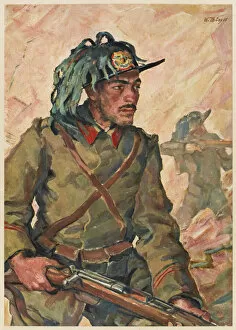Infantry Collection
Infantry: The Backbone of Warfare From ancient Roman legions to modern-day armies, the infantry has always been at the forefront of battle
All Professionally Made to Order for Quick Shipping
Infantry: The Backbone of Warfare From ancient Roman legions to modern-day armies, the infantry has always been at the forefront of battle. Their unwavering courage and unyielding spirit have shaped history and left an indelible mark on countless battlegrounds. The military badge worn proudly by these brave soldiers symbolizes their commitment to duty and sacrifice. It represents a long-standing tradition that dates back centuries, reminding us of their valor in the face of adversity. One such example is "The Last Stand of the 44th Regiment at Gundamuck during the Retreat from Kabul, 1841. " This harrowing event exemplifies the resilience displayed by infantrymen when faced with overwhelming odds. In "The Canadians at Ypres, " artist William Barnes Wollen captures another poignant moment in history. The image depicts Canadian soldiers bravely holding their ground amidst chaos and destruction during World War One. Scottish regiments also played a vital role in conflicts like World War One, as seen in "Badges of Scottish Regiments - World War One. " These badges represent not only pride but also honor for those who fought gallantly on foreign soil. Looking further back into history, we find ourselves witnessing pivotal moments like the Battle of Pyrenees in 1813. Here, infantry units clashed fiercely against formidable foes, displaying remarkable tenacity despite challenging terrain and harsh conditions. Fast forward to D-Day's landing on Omaha Beach; it was through sheer determination that Allied forces triumphed over adversity. Infantry troops stormed ashore under heavy fire, marking a turning point in World War Two's European theater. "The British army advancing at the Battle of Waterloo" showcases yet another defining moment where infantry formations proved instrumental in securing victory against Napoleon's forces. Their discipline and strategic maneuvers turned tides on that fateful day in 1815. Even ancient Rome recognized the importance of well-trained foot soldiers donning distinctive attire while marching into battle.
















































